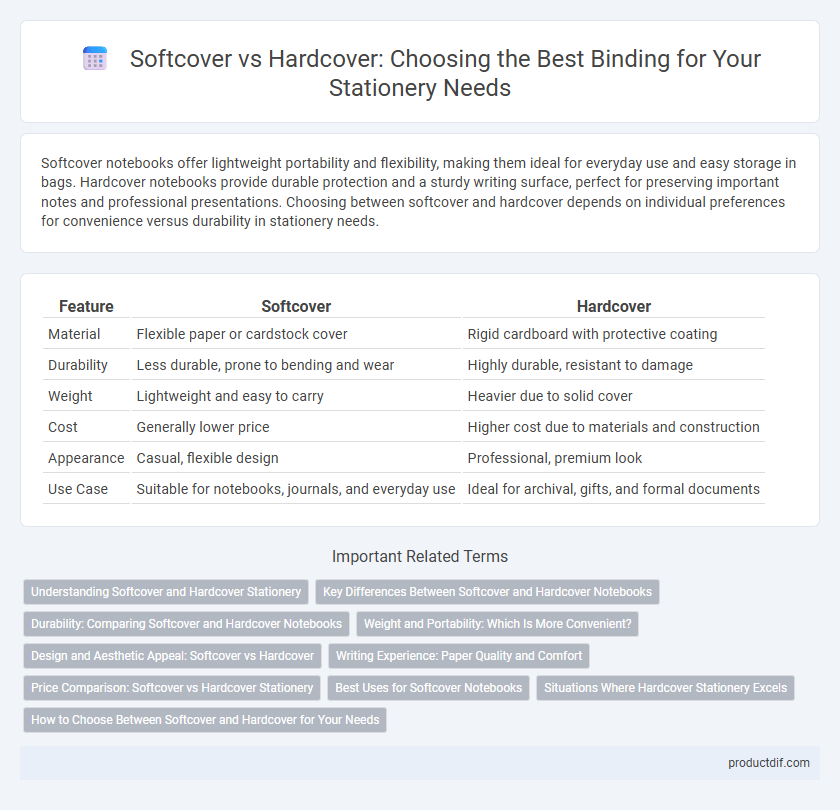Softcover notebooks offer lightweight portability and flexibility, making them ideal for everyday use and easy storage in bags. Hardcover notebooks provide durable protection and a sturdy writing surface, perfect for preserving important notes and professional presentations. Choosing between softcover and hardcover depends on individual preferences for convenience versus durability in stationery needs.
Table of Comparison
| Feature | Softcover | Hardcover |
|---|---|---|
| Material | Flexible paper or cardstock cover | Rigid cardboard with protective coating |
| Durability | Less durable, prone to bending and wear | Highly durable, resistant to damage |
| Weight | Lightweight and easy to carry | Heavier due to solid cover |
| Cost | Generally lower price | Higher cost due to materials and construction |
| Appearance | Casual, flexible design | Professional, premium look |
| Use Case | Suitable for notebooks, journals, and everyday use | Ideal for archival, gifts, and formal documents |
Understanding Softcover and Hardcover Stationery
Softcover stationery features flexible, lightweight covers made from thick paper or cardstock, offering portability and affordability ideal for notebooks and journals. Hardcover stationery uses rigid covers made from cardboard or wood, providing durability, protection, and a premium feel, often preferred for archival-quality notebooks and planners. Choosing between softcover and hardcover depends on balancing portability, protection, and aesthetic preferences for various stationery needs.
Key Differences Between Softcover and Hardcover Notebooks
Softcover notebooks feature flexible, lightweight covers made of cardstock or thick paper, allowing easy portability and affordability, while hardcover notebooks offer sturdy, rigid covers made of cardboard or leather, providing enhanced durability and protection. Softcover notebooks typically have a lighter overall weight and are more prone to damage, whereas hardcover versions resist wear and tear, making them ideal for long-term use and professional settings. The choice between softcover and hardcover impacts not only the notebook's lifespan but also its aesthetic appeal and user experience.
Durability: Comparing Softcover and Hardcover Notebooks
Hardcover notebooks offer superior durability with rigid covers that protect pages from damage, making them ideal for frequent use and long-term storage. Softcover notebooks, while more flexible and lightweight, are prone to bending, tearing, and wear over time. Choosing between softcover and hardcover depends on whether portability or lasting protection is prioritized for your stationery needs.
Weight and Portability: Which Is More Convenient?
Softcover notebooks typically weigh less than hardcover ones, enhancing their portability for everyday use. The flexible cover of softcover stationery allows easy storage in bags without adding bulk, making them ideal for students and professionals on the go. Hardcover notebooks offer durability but can be cumbersome for frequent transport, especially when weight is a critical factor.
Design and Aesthetic Appeal: Softcover vs Hardcover
Softcover books offer a flexible, lightweight design that enhances portability and allows for vibrant, full-color cover art, making them ideal for visually dynamic presentations. Hardcover books provide a sturdy, premium feel with embossed or foil-stamped covers, delivering a classic, elegant aesthetic that appeals to collectors and gift buyers. The choice between softcover and hardcover significantly influences the overall visual impact and tactile experience of stationery products.
Writing Experience: Paper Quality and Comfort
Softcover notebooks often feature lighter paper, enhancing portability but sometimes sacrificing smoothness and ink bleed resistance found in hardcover counterparts. Hardcover notebooks typically use thicker, higher-quality paper that supports various pen types and reduces ghosting, providing a more comfortable and reliable writing experience. The sturdy cover of hardcovers also ensures a stable surface, minimizing hand fatigue during extended writing sessions.
Price Comparison: Softcover vs Hardcover Stationery
Softcover stationery typically costs 30-50% less than hardcover options due to lower material and production expenses. Hardcover stationery offers enhanced durability and premium feel, justifying the higher price point in professional or gift settings. Choosing between softcover and hardcover depends on budget constraints and the desired longevity of the stationery product.
Best Uses for Softcover Notebooks
Softcover notebooks are ideal for students and professionals who need lightweight, portable writing tools that fit easily into bags and backpacks. Their flexible covers make them perfect for quick notes, sketching, and journaling on the go, while offering a cost-effective option for bulk purchases or daily use. Softcover designs also facilitate easier page turning and lay-flat usability, enhancing user comfort during extended writing sessions.
Situations Where Hardcover Stationery Excels
Hardcover stationery excels in professional settings where durability and a premium feel are essential, such as corporate meetings, presentations, and official documentation. Its rigid construction protects important notes and ensures longevity, making it ideal for archival purposes and frequent handling. The sturdy design also enhances the overall aesthetic, conveying a sense of quality and formality.
How to Choose Between Softcover and Hardcover for Your Needs
Choosing between softcover and hardcover depends on your priorities such as durability, cost, and portability. Hardcover books offer superior protection and a premium feel, ideal for collectors or gifts, while softcover books provide lightweight convenience and affordability, suitable for everyday use or bulk distribution. Consider the purpose of the stationery item, budget constraints, and how often it will be handled to select the best binding type for your needs.
Softcover vs Hardcover Infographic

 productdif.com
productdif.com